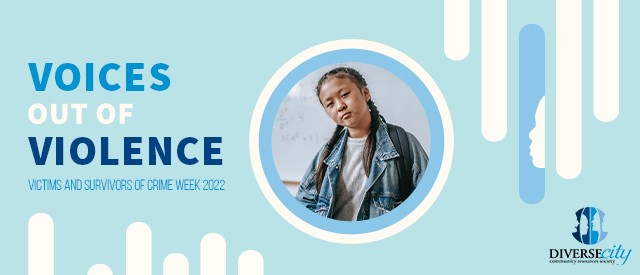Victims and Survivors of Crime Week (May 15–21, 2022): Discussing issues facing diverse victims of crimes and culturally safe resources and safety planning available to them
By Daniela Cohen
While gang members come from a range of ethnic, geographic, demographic and socio-economic contexts, youth from groups experiencing high levels of inequality and social disadvantage tend to be most at risk of recruitment.
A 2017 report titled Youth Gangs in Canada: A Review of Current Topics and Issues noted specific risk factors for Indigenous youth, immigrant youth and young women.
At-risk immigrant youth may come from poverty, extreme violence and brutality in their home countries, which are then exacerbated by mental health issues from experiences of discrimination and victimization in Canada. These youth may also not be engaged at school due to language barriers and lack of academic support at home as their parents focus on economic survival.
Pamela Sangha, a clinical counsellor at DIVERSEcity, explains that other general risk factors for youth joining gangs include “isolation, substance use, family dynamics, disruptive behaviour at school, difficulty making friends or not being able to maintain friendships, and financial hardship.”
SAFE program supports youth
DIVERSEcity is part of the Surrey Anti-Gang Family Empowerment Program (SAFE), which includes 10 partner agencies delivering individual programs to prevent gang violence. Partner agencies collaborate on a weekly basis at the Children and Youth At-Risk Table (CHART) to identify at-risk children and youth and support them and their family with a co-ordinated intervention plan.
As part of this multidisciplinary approach, DIVERSEcity provides the SAFE Community Clinical Counselling program. Free, culturally informed, confidential one-to-one and group-based counselling services are offered in English and first languages including Punjabi, Spanish, Farsi, Arabic, and Mandarin.
“We provide a lens in which we can work through anger, work through past trauma, and create boundaries, self-awareness and self-confidence,” says Pamela. “So that if someone were to try to recruit this person, they would be in a very confident place to establish boundaries around those behaviours.”
Other support offered by the SAFE partners includes school-based support as well as various mentorship programs.
Eleven-year-old Jas (name changed for privacy) had divorced parents who did not speak to each other. She was struggling with anxiety and didn’t want to attend school. She was also paying for things like getting her nails and lashes done with unexplained cash, an indicator for gang involvement. Jas received support through counselling and participated in a girl’s program. Pamela says she is now flourishing — getting straight A’s in school, continuing to attend counselling sessions and the girl’s group, and being supported by the RCMP through the SAFE program.
“It took a lot of agencies to get this going in the right direction,” Pamela says. “But eventually she came to an understanding through counselling and through the girl’s programs that she wanted more from her life.”
For Pamela, the process of countering youth gang recruitment is “a slow-moving wheel,” which requires daily effort, patience and persistence.
Resources for youth at risk of or involved in gang violence
Surrey Anti-Gang Family Empowerment Program (SAFE)
DIVERSEcity’s SAFE Community Clinical Counselling program
Children and Youth At-Risk Table (CHART)
RCMP Shattering the Image Anti-Gang Presentation
Youth Gangs in Canada: What do we know?
Youth Gangs in Canada: A Review of Current Topics and Issues

